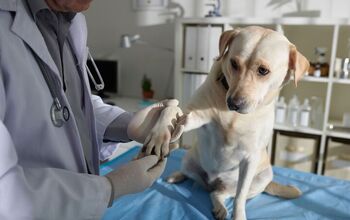Pros and Cons: Meal Feeding Vs Free Feeding Dogs

How and when do you feed your dog? Don’t think it’s important? Think again! Let’s go over the pros and cons of meal feeding vs free feeding dogs.
It turns out that there’s a lot to think about when it comes to feeding your four-legged chum. One of these things is if you should go with meal feeding or free feeding dogs. If you’re not aware of these concepts, here’s a quick rundown for you: Free-feeding is when you have food available for your pooch at all times and he gets to choose when and how much to eat. Meal feeding is when you give your dog meals at set times every day (ideally, twice a day for adult dogs and three times a day for puppies), and take them away after 30 minutes to an hour, if he doesn’t finish the lot. Of course, there are pros and cons to each method. Check them out and decide which way of feeding is right for you and your pup.
Related: How is Commercial Dog Food Regulated?
What is Free Feeding?
Just like it sounds–feeding freely an unlimited amount of food for your dog to graze on as he desires.
Sometimes it’s limited, as you can still control the portion you give, but you leave it to your dog to eat when he needs or wants, and how much at each time.
The thing is–not all dogs can be free feeders because they will just wolf all the food at once. It really depends on your dog, though, as many dogs do well with free-feeding if they feel secure in knowing there’s always a meal. In homes with multiple dogs, it’s less easy to ensure each dog gets just what they need.
What is Scheduled Feeding?
It’s probably just what you think of when you think of ‘feeding the dog.’ It’s giving your dog a set amount of food one to three times a day, and dependent upon each dog. Scheduled feeds typically go according to the dietary needs of a dog and your dog actually will start to ‘tell’ you when it’s time for breakfast or dinner.
Scheduled feeding often seems to be the choice of vets because it lets you really track what your dog eats, as well as how much. It lets you and your dog bond–with your dog knowing he can count on you. You’re able to help with potty training because you have a better idea of when he needs to potty and it may just be more convenient for you both.
Pros of Meal Feeding Dogs
- You control how much your dog eats, which should lessen the chance of overeating and obesity.
- It’s easier to notice if your dog is refusing food, which could be a sign that he’s unwell.
- It’s the most suitable way to feed wet or fresh foods that might go bad if left out for too long.
- If you have more than one dog, you can separate them at meal time if food aggression is a problem.
- It may lessen the chance of your dog getting bloat, and you’ll be around to get him veterinary treatment if he does bloat.
- Meals can be used as a reward.
- It gets your dog into a routine, which can help calm anxious pooches.
Related: AutoDiet Feeder Puts An End To Your Pets’ All-You-Can-Eat Buffet
Cons of Meal Feeding Dogs
- It’s best to stick to roughly the same meal times each day, so you need to be around at this time to feed your dog.
- You may accidentally be feeding your dog too much or too little.
- Your four-legged friend might feel pressured to eat, even if he’s not hungry.
Pros of Free-Feeding Dogs
- It’s more convenient for owners who don’t have a regular schedule. This is one of the most obvious advantages of free feeding. If you have a very busy daily schedule, or you are hit with an especially demanding work week, you can always count on your dog having ready food to eat. So, for example, you need to stay extra long at work today. Your dog will likely be fine without your company for those extra few hours, but they still need to eat. With free feeding, you can have that peace of mind, knowing that food is available to them.
- In theory, your dog should eat the correct amount of food for his needs (but, in practice, this isn’t always the case). A dog with balanced eating practices and a quality daily schedule, will often stick to the routines and norms of their daily life. This means that if they are used to eating a certain amount of food each time, the same will go for free feeding once you attempt it. So, even though there is a mountain of food in front of them, your doggo will eat the regular amount and return later for the next feeding time. But if you know your doggo is a voracious eater, this rule won’t work.
- Dogs don’t feel the pressure to eat their food right away, as they’re aware it will be there when they want it.
- Some people claim it can lessen food aggression. There are some doggos that are simply overly protective of their food. Even though no one threatens to take it, these pups will go the extra mile to make sure all the food is theirs. But when they know that there is plenty to go around, the drive to resource guard can quickly disappear.
Cons of Free-Feeding Dogs
- Can slow the progress of toilet training in puppies, as you can’t schedule post-meal potty breaks. While this might not be such a big con, and might not be so important this early on, it can still happen, especially if you are big about those post-meal potty breaks and potty training overall.
- Some dogs will eat even if they’re full, which can lead to obesity. Most doggos are very voracious, and will eat like a vacuum whenever they can. Imagine their joy when they face a big mound of food! So they will devour it, and eat and eat and eat, even after they had their fill. This overfeeding can lead to so many issues, especially with the digestive system. Bloating, gassiness, vomiting, diarrhea, and anything similar can become a big issue. But most dangerous is obesity which can quickly happen due to overfeeding. With obesity, your pet’s health is directly threatened in many ways, and you will need to react quickly.
- Free-fed dogs tend to be less food motivated, which can make training more difficult. A doggo with a full belly loves a good afternoon snooze. But a dog that knows there is a big pile of food always waiting around the corner, will have no motivation for anything else but snoozing and chilling. And that’s no good. A dog needs to be energetic and have exercise, and to follow that natural instinct of acquiring their food. When there’s food always ready in great amounts, the motivation to do anything else quickly drops down to zero.
- You can’t free-feed foods that will spoil. This is somewhat logical, but it’s worth mentioning. If you have dog food that really should not be left in the open for long, free feeding is immediately out of the question. Such foods will get spoiled really quickly, sometimes quicker than you think. This is especially true in those hot summer months. With such foods you are risking feeding your pet spoiled food, which can quickly lead to diarrhea, vomiting, and an upset stomach – at the very least.
As you can see, both methods have their good and bad points. It really boils down to you and you pooch. If you’re out a lot or work irregular hours, it might not be possible to meal feed your dog. However, if this is the case, you should bear in mind that dogs do need companionship and shouldn’t be alone too much of the time. As for your four-legged friend, if he’s the kind of dog who will eat everything in sight, no matter if he’s hungry or not, then free-feeding probably isn’t for him!

Lauren Corona is a freelance writer from merry old England. She specializes in writing about dogs and other critters. Lauren lives near Oxford, with her gorgeous Doberman, Nola. When she's not tapping away at the keyboard, you'll find her walking in the woods with Nola-dog, raising money for the Oxfordshire Animal Sanctuary, cooking vegan food, making zines and writing about herself in the third person.
More by Lauren Corona























